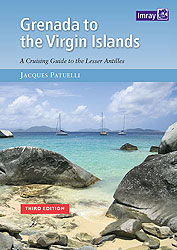| |
|

The island was discovered by Columbus
on 11th November 1493, St-Martin’s
Day. St-Martin was occupied by the
Spanish until 1644, in which year it was
conquered by Dutch forces commanded
by the Governor of Curaçao, Petrus
Stuyvesant, and French forces from St
Christopher. Four years later in 1648 the
island was split into two. Legend has it
that the border was drawn following a
walking race between a Dutchman
heading S and a Frenchman heading N
from Oyster Pond. Despite the rugged
terrain the Frenchman covered more
distance than the Dutchman, giving
France 3⁄5 of the 90sq km island. The
shrewd Dutch, however, got the salt
ponds of the S. Since then the division
has never been questioned, and, other
than during some English incursions in
the 18th century (finally ending in 1816),
the two flags have peacefully fluttered in
the same breeze for over three centuries.
Economically, salt from the salt ponds
was the major business of the Dutch for
a long time. Despite the dry climate and
arid soils, until the abolition of slavery,
which abruptly put an end to them, there
were also prosperous sugar cane
plantations. Despite a venture into cotton
growing and continuing exports of salt,
the island’s economy underwent a steady
decline. That lasted until the 1960s
when, especially in the Dutch half where
the international airport was built, the
tourism business started to grow.

|
|
|
|
Sint Maarten today
Since 1919, Sint Maarten had been part
of the Dutch Windward Islands alongside
Saba and Statia. Together with three
other territories in the Dutch Leeward
Islands N of Venezuela (Aruba, Bonaire
and Curaçao) they formed the
Netherlands Antilles.
However, in a referendum, Sint
Maarten’s population voted to secede
from this confederation and in 2010 it
became an autonomous state within the
Kingdom of the Netherlands.
If in the past the Sint Maarten
economy depended on sugar cane and
salt ponds, these days it’s all radically
changed and the duty free, tax free zone
is nicknamed the Little Hong Kong of the
Antilles. Real estate development is going
full tilt and reclamation in the lagoon
and levelling of the hills is helping
Philipsburg grow. The sole object of all
the hotel construction is to attract
tourists, preferably American. The dollar
rules, with the result that the florin (or
‘guilder’) is largely an administrative
fiction. In just the same way few speak
Dutch because everyday life is conducted
in English (if often mixed with the
papiamento of Curaçao). On official
maps all the names of places and bays,
etc. are in Dutch, though in fact the
tendency is more and more to call them
by anglicised versions.
|
|
|







